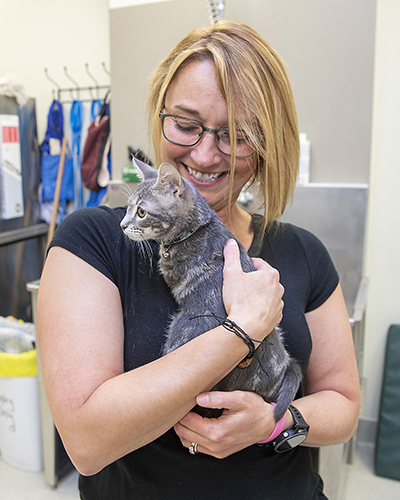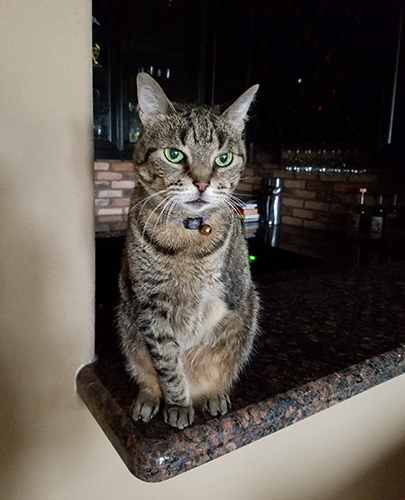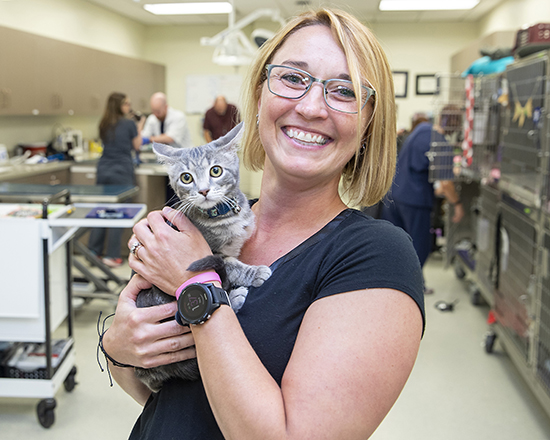Finding Crouton: A Curious Twist of Feline Fate
Story by Margaret Preigh, CVMBS Communications

Dr. Alison Diesel, a clinical associate professor at the Texas A&M College of Veterinary Medicine and & Biomedical Sciences (CVM), was not looking to adopt a cat when she first met Crouton.
“We had just lost the best cat in the world, Piddy, who had grabbed onto a piece of my heart and never let it go,” Diesel said. “I can say for certain there will never be another cat like her.”
Piddy had been diagnosed with GI lymphoma, a form of intestinal cancer, in February; the cancer was very aggressive and Piddy lost her battle at the end of May.
“When I returned to work three days later, I happened to be in the hallway outside of Dermatology,” Diesel said. “One of the surgery technicians at the time was holding a tiny gray tabby kitten, the same color as Piddy.”
That kitten, Crouton, had been found outside of a bar in downtown Bryan, brought into the Texas A&M Veterinary Medical Teaching Hospital (VMTH), and was subsequently treated for brachial plexus avulsion, which occurs when nerve roots stretch or tear from their attachment to the spinal cord. There is no treatment for brachial plexus avulsion, and with complete avulsion, the prognosis is often poor.
“There is a group of nerves that come off of the spinal cord and go down into the limb; they all meet at one spot, right underneath the cat’s front leg,” said Dr. Mark Stickney, the CVM clinical associate professor who performed Crouton’s operation. “If the cat experiences some kind of trauma, something that really causes tension on that leg, those nerves can only stretch so far.
“When they reach their breaking point, the brachial plexus tears loose from the spinal cord and those nerves to the leg are no longer functional. So, you have a paralyzed leg that can’t do anything,” Stickney said. “When the animal walks around, they’re dragging their paw on the ground and they end up getting wounds that become infected. The most common treatment is to amputate that leg.”

That was the case with Crouton, whose left front limb had to be amputated as the result of the brachial plexus avulsion. Stickney completed Crouton’s surgery with no complications, stressing that Crouton was a model patient.
“Crouton’s surgery was very routine and her recovery was excellent. Within hours of having her surgery she was up and purring, wanting to curl up with you. She was fantastic,” Stickney said. “Animals do really, really well on only three legs. Crouton is going to have an outstanding life.”
When Diesel learned the details of Crouton’s case, she couldn’t help but think of her Piddy, who had passed on the same day Crouton arrived at the Texas A&M Small Animal Hospital.
That was not the only coincidence Diesel found between the two cats.
“My Piddy was also a left front leg amputee due to a brachial plexus avulsion as a kitten. So, the two shared the same color hair coat, same arm, and same reason for needing amputation,” Diesel said.
“I don’t normally believe in these things, but I felt this was some part of the ‘universe’ reaching out,” Diesel said. “I struggled with the decision to adopt Crouton; we weren’t ready for a new cat—I thought it would be about a year before we got another one, but this little thing couldn’t be ignored.”
Believing that this kitten was meant to be in Diesel’s life, several close friends and fellow VMTH veterinarians planned to foster the kitten until Diesel was ready. However, preparations didn’t take long, and the kitten went home with Diesel just five days later.

“Crouton has fully wiggled her way into our hearts,” Diesel said. “She has become a very brave little cat.”
At home, Crouton joins three dogs: Brutus, the pug; Jelly, the mix; and Potato, the golden retriever.
“Her best friend is Potato; they love each other! They wrestle, they play, and she races him to the tennis ball—and often wins,” Diesel said.
Crouton’s amputation, which happened when she was only 7 weeks old, has failed to slow her down.
“She jumps around, can get up on all the counters—much to our chagrin—and climbs and plays,” Diesel said.
Crouton is now fully settled as part of Diesel’s home, though the coincidence of her arrival is still bewildering.
“Every once in awhile, I catch her doing something and have to stare at her a bit,” Diesel said. “Weird to say, but it does seem like a bit of Piddy’s soul has made it into the little Crouton cat.
###
For more information about the Texas A&M College of Veterinary Medicine & Biomedical Sciences, please visit our website at vetmed.tamu.edu or join us on Facebook, Instagram, and Twitter.
Contact Information: Jennifer Gauntt, Interim Director of CVM Communications, Texas A&M College of Veterinary Medicine & Biomedical Science; jgauntt@cvm.tamu.edu; 979-862-4216


